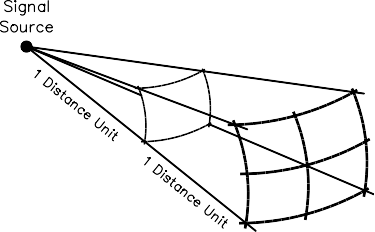Wave Attenuation and Absorption
Radio waves weaken as they travel, whether in the near vacuum of cosmic space or within the Earth’s atmosphere. Free-space attenuation results from the dispersal of radio energy from its source. See Fig 21.2. Attenuation grows rapidly with distance because signals weaken with the square of the distance traveled. If the distance between transmitter and receiver is increased from 1 km to 10 km (0.6 to 6 mi), the signal will be only one-hundredth as strong. Free-space attenuation is a major factor governing signal strength, but radio signals undergo a variety of other losses as well.
Energy is lost to absorption when radio waves travel through media other than a vacuum. Radio waves propagate through the atmosphere or solid material (like a wire) by exciting electrons, which then reradiate energy at the same frequency. This process is not per-
 fectly
efficient, so some radio energy is transformed into heat and retained
by the medium. The amount of radio energy lost in this way depends on
the characteristics of the medium and on the frequency. Attenuation in
the atmosphere is minor from 10 MHz to 3 GHz, but at higher
frequencies, absorption due to water vapor and oxygen can be high.
fectly
efficient, so some radio energy is transformed into heat and retained
by the medium. The amount of radio energy lost in this way depends on
the characteristics of the medium and on the frequency. Attenuation in
the atmosphere is minor from 10 MHz to 3 GHz, but at higher
frequencies, absorption due to water vapor and oxygen can be high.
Radio energy is also lost during refraction, diffraction and reflec- tion—the very phenomena that allow long-distance propagation. Indeed, any form of useful propagation is accompanied by attenua-
tion. This may vary from the slight losses encountered by refraction from sporadic-E clouds near the maximum usable frequency, to the more considerable losses involved with tropospheric forward scatter or D-Layer absorption in the lower HF bands. These topics will be covered later. In many circumstances, total losses can become so great that radio signals become too weak for communication.
Fig 21.2—Radio energy disperses as the square of the distance from its source. For the change of one distance unit shown the signal is only one quarter as strong. Each spherical section has the same surface area.
